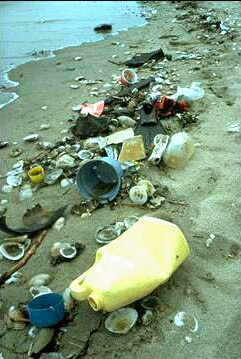|
Pollution and Waste Increasing Despite More Efficient Use of Resources A new report released today by the World Resources Institute (WRI) reveals that the total output of wastes and pollutants in Austria, Germany, Japan, the Netherlands, and the USA has increased by as much as 28 percent since 1975 despite their increasing efficiency in using natural resources. The report also reveals that from one-half to three-quarters of the annual resource inputs used in these five countries are returned to the environment as wastes within one year. The resource efficiency gains brought about by the rise of e-commerce and the shift from heavy industries toward knowledge- and service-based industries have been more than offset by the tremendous scale of economic growth and consumer choices that favor energy- and material-intensive lifestyles," said Emily Matthews of WRI and lead author of The Weight of Nations: Material Outflows from Industrial Economies. She added that by its very nature, economic growth poses a fundamental challenge to the environment's capacity to provide sufficient resources and absorb wastes without serious degradation. Better government policies and savvy management practices on the part of industry can help to break the link between economic growth and resource consumption and waste," Matthews said. The study was carried out by a team of researchers from Austrias Institute of Interdisciplinary Studies of Austrian Universities, Germanys Wuppertal Institute, Japans National Institute for Environmental Studies, The Netherlands Centre of Environmental Science at Leiden University and the World Resources Institute. The researchers documented the flow of raw materials -- including minerals, fossil fuels, timber, and other agricultural products in Austria, Germany, Japan, The Netherlands, and the United States. These accounts of the complete "materials cycle" or the flow of raw materials through the processes of extraction, production, use, and disposal can be evaluated alongside traditional monetary indicators, such as gross domestic product (GDP), to measure the materials intensity of a country. The higher the number of goods produced per unit of raw material or energy input, or waste output, the more efficient a country is in using its resources. The report concludes that standard economic indicators alone, such as the GDP, are insufficient for evaluating the true state of global economies. Such indicators, the authors write, neglect to consider whether or not countries make efficient and sustainable use of the natural resource base upon which their economies depend. "Not only does such inefficiency strain the capacity of air, soil, and water to absorb such waste, but it's also poor business practice," said Matthews. "Why continue to waste expensive raw materials when becoming more resource-efficient can increase companies' profit margins and also protect the environment?" The researchers also found that even though many countries have been successful in regulating some of the most hazardous wastes, such as lead and sulfur, outputs of many potentially harmful materials, such as arsenic, continue to increase. The authors argue that this lack of control is largely due to the fact that such emissions often occur at the extraction, use, or disposal phases of the material cycle, instead of the more regulated production phase. They conclude that national accounts tracking the entire material cycle would provide policy-makers, industry leaders, and the public at large with more comprehensive information on the extraction, use, and disposal of such potentially dangerous wastes. "We must understand the entire materials cycle, since neither governments nor industries can effectively manage what they don't measure," said Matthews. The report confirms that the extraction and use of fossil energy resources dominated output flows in all five countries. It shows that, excluding "hidden" waste flows, carbon dioxide emissions account for more than 80 percent, by weight, of total waste flows in the countries studied. The atmosphere is by far the biggest dumping ground for industrial wastes, said Matthews. There are positive trends, however. The study found that quantities of solid wastes sent to landfills have stabilized or declined in some study countries by 30 percent or more. Such reductions have been achieved, in part, through increased recycling efforts. Yet, the authors conclude, developing countries can be expected to attain roughly the same high level of materials-intensity as the industrialized countries. "Only if the level of materials intensity at which industrialized and developing counties eventually converge is substantially below that found in industrialized countries today can there be hope of mitigating global environmental problems and sustainably supporting the world's growing population," said Matthews. .
|

